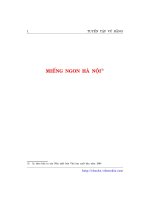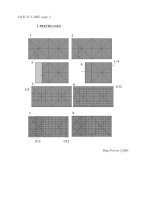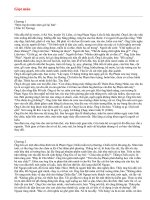Pencil portrait ppt
Bạn đang xem bản rút gọn của tài liệu. Xem và tải ngay bản đầy đủ của tài liệu tại đây (93.61 KB, 4 trang )
Pencil portrait
Materials: 2B, 3B or 4B pencil and paper.
When you draw a portrait from life, you
need to record the subtle variations of the
features which make that individual's face
unique.
There are three basic stages in the creation
of this image:
1. Using line drawing to organise the
position, shape and proportion of the
features.
2. Using softly shaded tone to create the
form and texture of each feature.
3. Using larger areas of tone to unite all the
elements of the portrait.
Pencil Portrait - Step 1- laying down the
basic features
Most artists make the greatest number of changes at
the start of a drawing. Therefore it is important to draw
lightly at first, as lightly drawn lines are easier to erase.
Begin a portrait with the eyes as they are the main
focal point. Take care where you choose to position
them on the page as this will affect the overall balance
of the portrait.
Mouse over the
image and you will see that nearest eye
is situated on the vertical centre of the page. This is a
strong compositional starting point for a three quarter
view portrait.
The size and position of the other features are directly
related to the scale and placement of the eyes.
If you get this stage right, you will end up with a good
likeness.
Pencil Portrait - Step 2 - the full outline
The next step is to set the distances between the eyes
and the top of the head and the eyes and the chin.
These measurements should be similar.
The main features are then framed by the outline of
the face and hair, while the neck and shoulders form
an angular support for the head. The hairline on the
right side of the face creates a sweeping curve as it
meets the neckline of the t-shirt. This movement
builds a strong visual link between the head and
shoulders.
At this stage, the drawing is a set of carefully
positioned features that establish the final proportions
of the portrait.
Pencil Portrait - Step 3 - some extra
linework
The final stage of the line drawing in this portrait is to
sketch some of the detail in the hair and the folds on
the t-shirt.
These lines of detail in the hair should follow the
direction and shape of the locks as they split into
different strands. They should be drawn fast and
forcefully to give a natural rhythm and vitality to the
surface of the hair.
The folds in the t-shirt help to emphasise the form and
angle of the shoulders. They should be gentle and
uncomplicated curves that do not distract your
attention from the rest of the head.
Pencil Portrait - Step 4 - the tone of the
eyes
Return to the eyes to begin the tonal development of
the portrait. Tone used around the eyes should:
Help them to sit solidly in their sockets by creating a
shadow beneath each eyelid where it rests on the
eyeball.
Give them a sparkling look by placing the brightest
highlight against the dark pupil.
Create the translucent effect of the iris by simulating
its changing tone.
Create the curved planes of the eyelids and sockets
with softly graduated tones.









